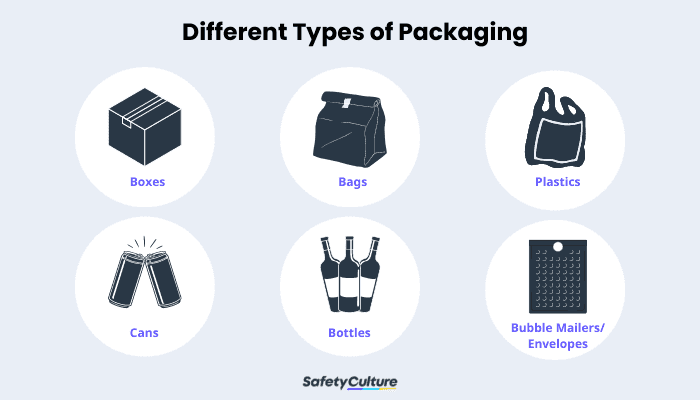What is Packaging?
Packaging is the process of enclosing or protecting a product for distribution, storage, sale, and use. Packaging also refers to the materials used to cover or wrap a product. The packaging of a product can be performed manually or using automated machinery.
Packaging is essential for marketing and product recognition. It creates value for the product and acts as a communication tool between the customer and the manufacturer. The packaging must also protect the product from damage during transport and storage.
What are the Different Types of Packaging?
When it comes to packaging, there are many different types and styles to choose from. The type of packaging you use will depend on the product you are packaging, the intended use, and your budget. Some common types of packaging include:

Types of Packaging
1. Boxes
Boxes are one of the most common types of packaging. They can be made from a variety of materials, including cardboard, corrugated cardboard, chipboard, and more. Boxes are typically used for packaging larger items or items that need to be protected from the elements such as long-distance delivery, breakage, and many more.
2. Bags
Bags are another common type of packaging. They can be made from materials such as paper, plastic, cloth, and more. Bags are typically used for packaging smaller items or items that required simple packaging for carrying or presentation/gift.
3. Plastics
Plastics are also quite common as a type of packaging. They are often made from various types of plastic materials, such as polyvinyl chloride (PVC), polyethylene terephthalate (PET), high-density polyethylene (HDPE), and more. Plastics are often used for packaging because they are durable and can be easily molded into different shapes.
4. Cans
Cans are often used for food and beverage packaging due to their various advantages to perishable items such as:
- Hermetically sealed
- Excellent protection from rodents and insects
- Stackable
- Tamper-resistant
- Inexpensive
Cans can be made from various types of materials including aluminum, steel, and more.
5. Bottles
Bottles are also quite common as a type of packaging. They can be made from a variety of materials, including glass, plastic, and more. Bottles are often used for packaging liquids and other items that need to be airtight.
6. Envelopes and Bubble Mailers
Envelopes and bubble mailers are often used for letters, cards, and other small items that need to be protected during shipping. They can be made with plastics, papers, foils, and many more, depending on the importance and use of what it contains.
Why Is It Important to Understand Packaging Types?
When it comes to understanding the types of packaging, it is important to consider the needs of your product. Some products require more protection than others, and others are better suited for certain types of packaging.
By knowing the types of packaging, you can make sure that your product is properly protected and that you are using the most suitable type of packaging for your needs. This can save you time and money in the long run, and it can also help improve the quality of your product.
What are the Benefits of Packaging?
Packaging can actually be a powerful marketing tool that can help you sell more products and attract more customers. This is why packaging is a very essential to a business.
Here are just a few of the benefits that packaging can provide:
- Protection: Packaging can help to protect your product from damage during shipping and storage.
- Tamper Resistance: Packaging can deter thieves and help ensure that your product is not tampered with before it reaches the customer.
- Product Visibility: Packaging can make your product more visible on store shelves and online, which can help to boost sales.
- Increased Sales: Packaging can increase sales by making your product more appealing to customers.
- Brand Recognition: Good packaging can help to build brand recognition and loyalty. It will make your consumers more attracted to the product and build loyalty to your brand.
Create Your Own Packaging Inspection Checklist
Eliminate manual tasks and streamline your operations.
Get started for FREEWhat are the 3 Levels of Packaging?
There are three levels of packaging: primary, secondary, and tertiary.
- Primary packaging is the first level of packaging and is in direct contact with the product. It is designed to protect the product and to be the first layer of defense against the outside environment.
- Secondary packaging is the second level of packaging and is used to protect the primary packaging. It is also designed to provide additional support and stability to the product.
- Tertiary packaging is the third and final level of packaging. It is used to protect the product during transportation and to display the product in a retail setting.
FAQs for Types of Packaging
Packaging has 5 main purposes: protection, containment, information, utility of use, and promotion. These all provide a significant advantage to the product, the company, and the consumer.
The main role of packaging is to provide the product with adequate protection from elements that can damage it, such as breakage, moisture, heat, rodents, and many more. This way, the quality of the product is preserved as it reaches the customer.
The five elements of packaging consist of:
- quality;
- colors;
- visuals;
- format; and
- typography.
These elements allow the brand to be easily relatable to the consumers and make them have more recall.
Yes. Companies and manufacturers must follow the ISO/IEC Guide 41, the ISO standard for packaging. Following this standard will provide consumer satisfaction and the packaging more effective and secure from the factory to the market.



